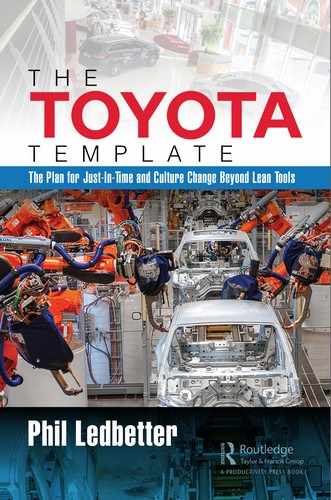The Problem: Distance from Toyota
Problems require solutions.
The lean world has become an interesting place over the years. Lots of companies in many different industries all over the world have been, and are, attempting to implement lean systems. However, the overwhelming rate of failure is hard to understand. Most estimates are in the 90% range, some even higher. I’ve often wondered why this is so. What’s the problem? As I considered my experience at Toyota, researched the history, and observed what’s been going on, many thoughts came to my mind.
It’s well known that Toyota has been the gold standard for any company attempting its own lean implementation. People from all over the world have toured the Toyota plant in Georgetown, Kentucky, over many years. Even though I worked there, I’ve taken the public tour myself a few times out of curiosity. What people see on the tour is the current product of the Toyota Production System (TPS), which took many years, through trial and error, to develop.
[T]he Toyota Production System evolved gradually, step-by-step. Taiichi Ohno, Kikuo Suzumura, and others conceived elements of the system and worked heroically to put their concepts into practice. But none of those individuals ever possessed a comprehensive vision of the Toyota Production System as an integrated framework. They were simply tackling problems that arose in the workplace, one by one, and their solutions accumulated and gradually became—collectively—what we now know as the Toyota Production System. 1
Toyota has been very open with their system since arriving in the United States. The extreme example was their 25-year joint venture from 1984 to 2009 in Fremont, California with General Motors (GM), called NUMMI. GM had full access to every part of the production system and training from hundreds of Toyota trainers. Yet, it has proved very difficult for them and others to implement real lean systems that approach the efficiency of Toyota. As I pondered this reality, my mind repeatedly arrived at the obvious question. Why?
Many companies that are successful, or at least making money, have decided, albeit cautiously, to take the plunge to become efficient. These companies have employed many resources, including outside help and benchmarking visits to those places they believe to be helpful, and spent a lot of money on production boards, kanbans, returnable dunnage, and any number of tools in search of a lean culture change, reduced costs, and world-class on-time-delivery.
These are good companies, with good products that are in demand in the market, that are looking for improvement that differentiates them from their competitors. Either they realize that there’s room for improvement or they fear falling behind the competition. Either way, from an efficiency standpoint, companies today are in a similar position to that of Toyota prior to the development of the TPS. They’re running with the herd. And, let’s be honest, there’s some safety in the herd. Excessive inventory, unsynchronized production, poor housekeeping, and excessive costs are common problems today, just as they were at Toyota many years ago. Unfortunately, many don’t realize they have problems, because they’re comfortably settled in with the herd.
Since companies today are in a similar starting position, wouldn’t it make sense to understand what Toyota did when they were in this same spot? If we agree that Toyota is the leader and best example of a “lean” company, wouldn’t it be instructive to examine the Toyota record to understand what they did, why they did it, how they did it, and the results? And how did the steps they took lead to the development of that elusive lean culture?
Once the what, the when, the why, and the how are deeply understood, wouldn’t there exist a template for a successful lean implementation? Absolutely! If companies today that strongly desire to become efficient manufacturers, world class in their markets, were to set about following this “Toyota Template,” shouldn’t it follow that they could become efficient and world class? Yes!
The fact is that a successful and sustainable lean production system and culture requires the implementation of the “Toyota Template.” In fact, it’s the only way to become an efficient, just-in-time company. TPS is the benchmark for all lean initiatives. In this book, I’ll examine the key steps and concepts Toyota took under the leadership of Taiichi Ohno, with the full support of Kiichiro and Eiji Toyota, and develop this Toyota Template.
The Problem: Distance from the Toyota Template. Lean efforts are far away from the TPS.
Culture: Culture is not grown through tools. The culture developed because of the steps Ohno took over time.
1. Shimokawa, Koichi and Fujimoto, Takahiro. 2009. The Birth of Lean, p. 129. Cambridge, MA: The Lean Enterprise Institute.
